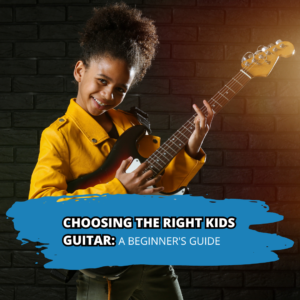Choosing the Right Kids Guitar: A Beginner’s Guide

Understanding Guitar Sizes and Types
Choosing the right kids guitar involves more than just picking out a favorite color or style; it’s about understanding the nuances between different guitar sizes and types to ensure the best fit for your child.
Determining the Right Size for Your Child
Selecting the right size of a kids guitar is crucial for ensuring your child’s comfort and playability. Guitars come in various sizes, typically ranging from 1/4, 1/2, 3/4, to full-size instruments. For younger children, a 1/4 or 1/2 size guitar might be most appropriate, as these are designed to fit smaller hands and bodies. As children grow, they can transition to 3/4 and eventually full-size guitars.
The correct size helps prevent strain on the arms and shoulders, making the learning process more enjoyable. Measure your child’s arm length and compare it to the guitar size charts available in most music stores to find the perfect fit. Remember, a properly sized guitar can greatly enhance your child’s learning experience and motivation.
Acoustic vs. Electric: Which is Best for Beginners?
When choosing between an acoustic and an electric kids guitar, consider your child’s musical interests and the practicalities of each type. Acoustic guitars are often recommended for beginners due to their simplicity and the fact that they don’t require additional equipment like amplifiers. They’re great for learning basic chords and fingerpicking techniques.
On the other hand, electric guitars are typically easier to play because of their lighter strings and smaller necks, which can be advantageous for children with smaller hands. Electric guitars also allow for a wider range of sounds and styles, which might be more appealing to kids interested in rock, pop, or metal genres. Ultimately, the best choice depends on your child’s preferences and the type of music they aspire to play.
Setting a Budget for Your Child’s Guitar
Investing in a kids guitar is a significant first step towards nurturing your child’s musical talent. However, with the wide range of options available, setting a realistic budget becomes essential.
Price Range for Beginner Guitars
Setting a realistic budget for a kids guitar is an important step in the purchasing process. Beginner guitars can range in price from under $100 to several hundred dollars, depending on the quality, brand, and type. Generally, a decent starter guitar can be found for around $150 to $300. This price range is ideal for a quality instrument that will be both playable and durable. Investing in a slightly higher-priced guitar can often mean a better sound quality and a more enjoyable playing experience for your child. However, it’s also important to balance cost with your child’s level of interest and commitment to learning the guitar.
Key Features of a Child-Friendly Guitar
Selecting a child-friendly guitar goes beyond price and size; it’s about identifying the features that will make the learning process as smooth and enjoyable as possible.
Importance of Playability and Comfort
A child-friendly kids guitar must prioritize playability and comfort to encourage practice and learning. The action, or the distance between the strings and the fretboard, should be low enough to make pressing the strings easier for small fingers but not so low that it causes buzzing. The neck’s width and shape should fit comfortably in your child’s hand, allowing for easy movement along the fretboard. Lightweight guitars are also preferable, as they are easier for children to hold and play, reducing the risk of discomfort or injury. Playability directly impacts a child’s enthusiasm for learning the guitar, so it’s essential to choose an instrument that feels good to play.
Additional Features to Look For
Beyond playability and comfort, several additional features can make a kids guitar more appealing and suitable for young learners. Look for guitars with nylon strings, which are softer on the fingers compared to steel strings, making them ideal for beginners. The quality of the tuning pegs is also important; they should turn smoothly and maintain their tuning to minimize frustration during practice sessions. Some guitars come with built-in tuners, which can be very handy for beginners. Additionally, the guitar’s overall build quality should be robust enough to withstand the occasional bumps and knocks it may endure during the learning process. These features collectively contribute to a positive and encouraging learning environment for your child.
Making the Purchase: Tips and Recommendations
The final step in choosing the right kids guitar is making the purchase, but this can be daunting with so many options available.
Where to Buy a Kids Guitar
Purchasing a kids guitar can be done at local music stores, online marketplaces, or through direct manufacturers. Local music stores offer the advantage of trying before buying, which is invaluable for ensuring the guitar is a good fit for your child. Online purchases can be convenient and sometimes offer a broader selection and better prices, but it’s important to buy from reputable websites and check return policies. Consider looking for stores or sites that specialize in musical instruments for children, as they often provide valuable advice and appropriate options. Always read reviews and possibly consult a guitar teacher before making the final decision to ensure the instrument is suitable for a beginner.
Testing the Guitar Before Purchase
Testing the guitar before purchase is crucial to ensure it meets your expectations in terms of sound quality, playability, and comfort. If you’re not familiar with playing the guitar yourself, consider bringing along someone who is, or ask for assistance from a store employee. Check for the ease of playing in different positions, the comfort of the guitar body against the child’s body, and any potential manufacturing defects. Listen for a clear, rich sound that resonates well, indicating the guitar’s good quality. Additionally, paying attention to your child’s reaction and comfort with the guitar can provide valuable insights into whether it’s the right choice.
Elite Music Academy: Unleashing Your Child’s Musical Potential
At our music academy, we understand that the journey to musical mastery begins with the first note played on the perfect instrument. That’s why we’re dedicated to providing not just high-quality guitar lessons tailored for kids but also guidance in selecting the right kids guitar. Our experienced instructors are passionate about making music education accessible, engaging, and fun for children of all ages. With a focus on nurturing each student’s unique talents and interests, we offer a supportive environment where young musicians can thrive, develop their skills, and fall in love with the art of guitar playing. Join us, and let’s embark on a musical adventure that will unlock your child’s potential and ignite their passion for music!
FAQs
1. What are the signs that a guitar is too big or too small for my child?
Signs a guitar is too big include difficulty in reaching the strings comfortably with both hands and struggling to wrap their arms around the body. If it’s too small, your child may appear cramped and unable to move their fingers freely along the fretboard.
2. Can a child start learning on a full-size guitar?
While it’s possible, starting on a guitar that matches their size is generally recommended for comfort, ease of learning, and to avoid strain. A full-size guitar may be suitable for older children or those with larger hands and longer arms.
3. How often should my child practice guitar as a beginner?
Beginners should aim for at least 15-30 minutes of practice per day. Consistency is key to building muscle memory and skill.
4. What should I do if my child loses interest in their guitar?
Explore the reasons behind their loss of interest. It could be related to the difficulty level, the type of music, or the need for more engaging lessons. Sometimes, trying a different musical style or incorporating more fun elements into practice can reignite their passion.
5. What accessories are essential when purchasing a kids guitar?
Essential accessories when purchasing a kids guitar include a guitar tuner, picks, a strap (especially for standing play), a capo (for advanced playing), and a sturdy case or gig bag for protection.
6. Can learning guitar help with my child’s academic performance?
Studies suggest that learning a musical instrument can improve cognitive skills, such as memory, attention, and problem-solving, which can positively impact academic performance.






